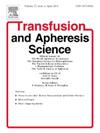Correlation between blood parameters in the early and later stages of pregnancy: A retrospective study
IF 1.4
4区 医学
Q4 HEMATOLOGY
引用次数: 0
Abstract
Objective
Anemia is common in pregnant women and is associated with various maternal and fetal complications. However, the effect of fluctuations in hemoglobin levels during pregnancy on birth outcomes remains unclear. Therefore, we investigated the association between maternal hemoglobin levels at different stages of pregnancy and delivery outcomes.
Methods
This retrospective study included 215 women who gave birth between 2018 and 2023. Hemoglobin levels were measured at three time points during pregnancy: first trimester (approximately 12 weeks), second trimester (13–27 weeks), and third trimester (28–36 weeks). The primary outcomes were the associations between hemoglobin levels and birth weight, birth weight Z-score, placental ratio, and placental weight. Statistical analyses were conducted to control for maternal and fetal factors and to determine the correlations between hemoglobin levels and delivery outcomes.
Results
Hemoglobin levels in the first trimester were the best predictors of anemia in the third trimester (area under the curve (AUC), 0.63; sensitivity, 65 %; specificity, 65 %). Hemoglobin levels were inversely associated with birth weight, birth weight Z-score, placental ratio, and placental weight. The overall accuracy of predicting iron-deficiency anemia was high (sensitivity, 71 %; specificity, 76 %; AUC, 0.76). Significant associations were observed at p < 0.001.
Conclusions
Fluctuations in hemoglobin levels during pregnancy were significantly associated with adverse birth outcomes. Monitoring and managing hemoglobin levels early in pregnancy can improve maternal and fetal health by reducing the risk of low birth weight and other complications. Further research is needed to explore the mechanisms underlying these associations and develop targeted interventions.
妊娠早期和晚期血液参数的相关性:一项回顾性研究
目的贫血在孕妇中很常见,并与多种母胎并发症有关。然而,怀孕期间血红蛋白水平的波动对分娩结果的影响尚不清楚。因此,我们研究了妊娠不同阶段母体血红蛋白水平与分娩结局之间的关系。方法本回顾性研究包括2018年至2023年间分娩的215名妇女。在妊娠期间的三个时间点测量血红蛋白水平:妊娠早期(约12周)、妊娠中期(13-27周)和妊娠晚期(28-36周)。主要结局是血红蛋白水平与出生体重、出生体重z评分、胎盘比例和胎盘重量之间的关系。进行统计分析以控制母胎因素,并确定血红蛋白水平与分娩结局之间的相关性。结果妊娠早期血红蛋白水平是妊娠晚期贫血的最佳预测指标(曲线下面积(AUC), 0.63;敏感性,65 %;特异性65 %)。血红蛋白水平与出生体重、出生体重z评分、胎盘比例和胎盘重量呈负相关。预测缺铁性贫血的总体准确度较高(敏感性为71 %;特异性,76 %;AUC, 0.76)。p <; 0.001观察到显著相关性。结论妊娠期血红蛋白水平波动与不良分娩结局显著相关。妊娠早期监测和管理血红蛋白水平可以通过降低低出生体重和其他并发症的风险来改善孕产妇和胎儿健康。需要进一步的研究来探索这些关联的机制并制定有针对性的干预措施。
本文章由计算机程序翻译,如有差异,请以英文原文为准。
求助全文
约1分钟内获得全文
求助全文
来源期刊
CiteScore
3.60
自引率
5.30%
发文量
181
审稿时长
42 days
期刊介绍:
Transfusion and Apheresis Science brings comprehensive and up-to-date information to physicians and health care professionals involved in the rapidly changing fields of transfusion medicine, hemostasis and apheresis. The journal presents original articles relating to scientific and clinical studies in the areas of immunohematology, transfusion practice, bleeding and thrombotic disorders and both therapeutic and donor apheresis including hematopoietic stem cells. Topics covered include the collection and processing of blood, compatibility testing and guidelines for the use of blood products, as well as screening for and transmission of blood-borne diseases. All areas of apheresis - therapeutic and collection - are also addressed. We would like to specifically encourage allied health professionals in this area to submit manuscripts that relate to improved patient and donor care, technical aspects and educational issues.
Transfusion and Apheresis Science features a "Theme" section which includes, in each issue, a group of papers designed to review a specific topic of current importance in transfusion and hemostasis for the discussion of topical issues specific to apheresis and focuses on the operators'' viewpoint. Another section is "What''s Happening" which provides informal reporting of activities in the field. In addition, brief case reports and Letters to the Editor, as well as reviews of meetings and events of general interest, and a listing of recent patents make the journal a complete source of information for practitioners of transfusion, hemostasis and apheresis science. Immediate dissemination of important information is ensured by the commitment of Transfusion and Apheresis Science to rapid publication of both symposia and submitted papers.

 求助内容:
求助内容: 应助结果提醒方式:
应助结果提醒方式:


